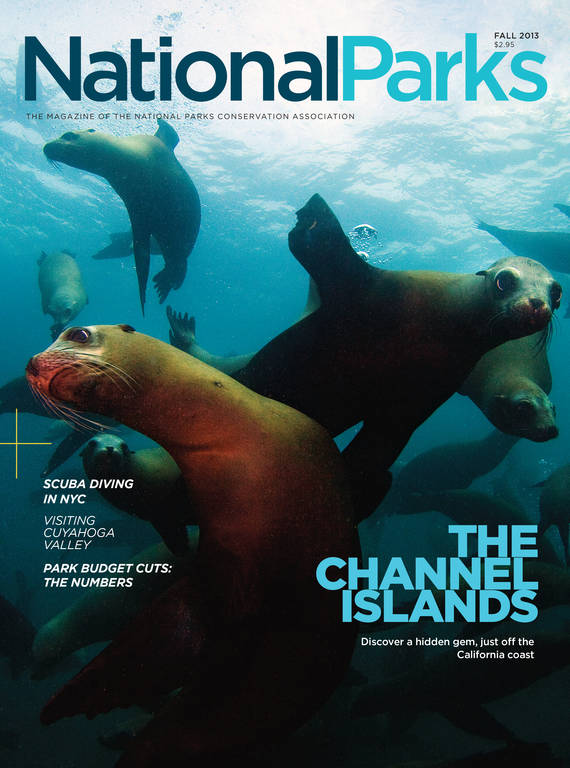Fall 2013
On A Ledge
Wolverines may soon be listed as a threatened species.
In the spring of 2009, a wolverine known as M56 walked out of his home in Wyoming’s Teton Range and headed south. According to his tracking implant, he scaled craggy cliffs and fields of talus. He traveled roughly 500 miles over state lines and six-lane highways. On June 26 that year, M56 showed up in the sights of a photographer’s lens in Colorado’s Rocky Mountain National Park—and caused quite a stir. It was the first sighting of a wolverine in the state since 1919, and the first glimpse of a wolverine in the park since its creation.
“It was a great illustration of wolverines’ scale of movement,” says Jeff Burrell, a biologist and Northern Rockies program coordinator for Wildlife Conservation Society, which ran a wolverine monitoring study in the Yellowstone area. It also reminds us, Burrell says, that wolverines are a natural part of Colorado’s landscape and rely on the ability to roam across large connected territories.
M56 appears to be the lone wolverine in Colorado, but he may have company soon. In February, the U.S. Fish and Wildlife Service (FWS) proposed listing the American wolverine as threatened under the Endangered Species Act. Though their numbers are slowly growing, fewer than 300 wolverines populate the United States, and climate-change predictions suggest a drastic reduction of their habitat. According to the FWS, wolverine habitat could shrink by 31 percent by 2045 and 63 percent by 2085, potentially threatening the species with extinction.
The agency also announced several other proposals with the potential listing. Unlike more controversial listings, this one would specifically allow human activities, such as skiing, snowmobiling, and logging, to continue in the wolverines’ high-elevation habitat, because FWS doesn’t believe that wolverines are significantly affected by those impacts. (Hunting and trapping the animals, however, would be illegal.) Another FWS proposal: reintroducing the feisty critters into their native range, starting with Colorado. When the agency solicited public comments this spring, more than 100,000 people weighed in—both supporters and detractors. By February 2014, FWS will decide whether or not to add the species to the list.
“This is a matter of helping wolverines adapt to climate change,” says Shawn Sartorius, a FWS biologist specializing in wolverines. “They’re not going to adapt to warmer temperatures, but through reintroductions in historic parts of the range where they no longer occur, we can help wolverines establish populations and maintain numbers while they’re simultaneously losing some habitat to climate change.”
Already, without much—if any—help from human beings, wolverines have staged a shaky but undeniable comeback after near-extinction in the Lower 48. In the 19th century, trappers caught them for their thick, beautiful fur, which was used for winter coats on this continent and in Europe. Then, in the early 1900s, widespread trapping and poisoning programs largely aimed at wolves and bears unintentionally killed wolverines, nearly erasing them from the country’s wild landscapes.
A couple of decades after trapping practices started to change in the 1930s, wolverines from Canada trickled down into Idaho, Montana, Washington, and, ultimately, Wyoming and began to reproduce. The species’ tenacious grip on survival is perhaps a reflection of its shockingly fierce temperament. Wolverines are one of nature’s gnarliest predators. These mammals, the largest terrestrial member of the weasel family, resemble small bears with bushy tails. Although they rarely grow larger than 40 pounds, they have been known to spar with grizzlies and—when there’s not enough small prey, berries, and carrion—attack and kill wounded animals many times their size, like caribou. They prefer to inhabit the mountains’ most inhospitable corners: cold, steep, high-altitude areas laden with deep snow. And they’ve been known to travel as far as 30 miles per day over rugged, remote terrain.
But wolverines still haven’t repopulated their full home range in the United States, which also includes the high zones of California’s Sierra Nevada, Colorado, and New Mexico. Listing the wolverine as threatened could spur Colorado Parks and Wildlife to reintroduce the species in the state, which, if approved, could happen within a year or two of the decision. Theoretically, a wolverine reintroduction would transplant healthy individuals from Alaska and Canada to remote sites throughout Colorado.
“A lot of people believe that if you have wild places, you should have wild things,” says Eric Odell, species conservation project manager for Colorado Parks and Wildlife. Some Coloradans, however, oppose wolverine reintroduction out of concern that regulations to protect them would hamper human activities like skiing or logging, even though FWS officials have no current plans to move in that direction.
A listing wouldn’t immediately change much in the ecosystems, since the animals are relatively rare; nor would it immediately change management of the national parks, which comprise about 12 percent of wolverine habitat in the contiguous United States. (The species currently occurs in Glacier, Grand Teton, North Cascades, Rocky Mountain, and Yellowstone National Parks.) It would, however, add an extra measure of scrutiny in future planning projects and add another layer of protection.

National Parks
You can read this and other stories about history, nature, culture, art, conservation, travel, science and more in National Parks magazine. Your tax-deductible membership donation of $25 or more entitles…
See more ›National parks play an important role in providing refuge for these animals, and a valuable study area for researchers. In the last ten years, lack of research on wolverines halted FWS efforts to list the species under the Endangered Species Act. Partly as a result, biologists initiated monitoring studies in the greater Yellowstone and greater Glacier areas. Now, North Cascades is hosting a multiyear study of wolverines and recently debuted new camera traps, which could be used to document the species in more remote places.
“The park is a good laboratory because we don’t have any human activities that negatively impact the wolverine,” says Roger Christopherson, a wildlife biologist at North Cascades National Park. “The more we know about them, the better we can protect them.”
Meanwhile, the bachelor M56 is still likely roaming Colorado, perhaps in search of a lady friend. Several times a year, reports of sightings filter into the visitor centers of Rocky Mountain National Park, some more credible than others.
“Visitors know what they are and how unique and special it would be to see one in the wild,” says John Mack, branch chief of natural resources at Rocky Mountain National Park. Often, these sightings wind up being marmots or, in one case, a really muddy badger, but occasionally they do match the description of M56. “They capture people’s imaginations.”
Even if wolverines are still largely mysterious and rarely sighted—something unlikely to change with their listing under the Endangered Species Act—their presence seems to have an intangible value. It reminds us that wild places with wild things still do exist, and not only within the confines of our imaginations.
“They’re probably one of the most elusive carnivores,” says Christopherson. “But hiking around out there, by gosh, there just might be one watching you.”
About the author
-
 Kate Siber Contributor
Kate Siber ContributorKate Siber, a freelance writer and correspondent for Outside magazine, is based in Durango, Colorado. Her writing has appeared in National Geographic Traveler and The New York Times. She is also the author of “National Parks of the U.S.A.,” a best-selling children’s book.


